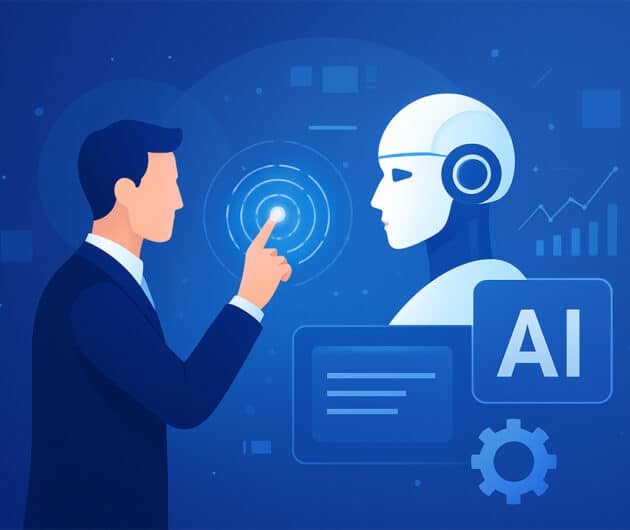Scaling AI Projects: Maximizing Impact While Minimizing Costs

-
Jignesh Nakrani
- September 17, 2025
- 9 min read
Scaling AI can feel overwhelming. You might think you need millions in funding, hundreds of GPUs, and a large team of data scientists just to get started.
The truth is—you don’t. Many successful AI projects start small, with limited resources, and scale smartly over time. It’s not about the biggest budget; it’s about strategy, efficiency, and the right tools.
Think of a startup building a recommendation engine. They started with a small dataset, used open-source models, and deployed on minimal cloud resources. By carefully optimizing their pipelines and focusing on high-impact use cases, they scaled across multiple regions without breaking the bank. The result? Improved revenue, faster insights, and measurable ROI.
Scaling AI is not about guessing or overinvesting. It’s about understanding where the cost sinks are, optimizing infrastructure, implementing robust MLOps practices, and making models and data pipelines lean and efficient. When done right, you can grow your AI project smartly—even on a small budget—and still deliver real business value.
This guide will walk you through practical strategies to scale AI projects. From infrastructure tips and model optimization to data management and cost-effective deployment, you’ll get actionable insights you can implement immediately, whether you’re a startup or an enterprise.
◉ Why Does Scaling AI Matter for Enterprises?
Scaling AI can seem like something only huge companies with massive budgets can do. The truth is—you don’t need millions or hundreds of GPUs to make AI matter. Even small teams can scale AI smartly and generate real business value. AI in digital transformation helps businesses work smarter, improve customer experiences, and make better decisions—without overspending.
• Drive Growth Without Breaking the Bank
AI can help you automate customer personalization, optimize operations, and predict trends—but only if it reaches the right scale. Take a small startup using a recommendation engine: starting with minimal resources and open-source tools, they scaled across multiple regions. The result? More revenue, faster insights, and a measurable ROI—all without overspending.
• Make Every Investment Count
AI isn’t cheap. Data, cloud infrastructure, and talent all cost money. Scaling ensures that your investment delivers maximum return. Deploying the same model across multiple teams or processes multiplies its value. That’s how smart scaling turns small wins into big impact.
• Stay Competitive in a Data-Driven World
Your competitors are already using AI to improve efficiency and customer experience. Scaling your models lets you keep up—and even get ahead. Companies that fail to scale risk falling behind in markets where AI is becoming the baseline expectation.
• Boost Efficiency Across the Organization
Scaling AI isn’t just about revenue—it also helps teams work smarter. Automated workflows, predictive maintenance, and intelligent analytics reduce repetitive tasks, minimize errors, and free people to focus on strategy. For example, a small manufacturing team scaled predictive maintenance across plants and cut unplanned downtime by 30%, saving both time and money.
Scaling AI matters because it turns small, pilot models into tools that deliver real business value. If done right, it can drive growth, improve efficiency, and give you a competitive edge—all without overspending.
◉ Challenges Enterprises Face When Scaling AI
Scaling AI sounds exciting, but the reality is often more complicated. Many enterprises start with strong proof-of-concept models but struggle when it’s time to roll them out at scale. Costs pile up, processes break, and ROI takes longer than expected.
Here are the most common roadblocks enterprises run into:
• High Infrastructure and Cloud Costs
Running AI isn’t cheap. Training and serving models require GPUs, large storage, and often high-performance cloud infrastructure. Without cost optimization, cloud bills can spiral out of control.
Example: A fintech startup saw its monthly GPU costs triple after scaling a fraud detection model without using auto-scaling or spot instances.
• Data Bottlenecks
AI depends on data, but getting that data ready for production is tough. Enterprises often struggle with messy pipelines, inconsistent formats, and the expensive process of data labeling.
Example: A logistics company delayed its automated package sorting system by six weeks because it relied on manual labeling for millions of images.
• Talent and Team Gaps
It’s not just about data scientists. Scaling AI requires MLOps engineers, data engineers, and domain experts working together. Many enterprises underestimate this, leading to stalled projects or models that never make it out of the lab.
• Operational Complexity
One model is manageable. Ten models across multiple regions? That’s where things get messy. Without proper monitoring, version control, and pipelines, enterprises risk downtime, errors, or conflicting results.
• ROI Uncertainty
Scaling for the sake of scaling doesn’t work. Some enterprises push models into production without linking them to clear business goals. The result? High costs with little measurable impact, and stakeholders lose confidence in AI initiatives.
◉ Strategies to Scale AI Smartly and Cost-Effectively
Scaling AI doesn’t mean spending big—it means spending smart. With expert AI development services and a clear enterprise AI strategy, businesses can focus on efficiency, automation, and impact-driven decisions.
• Start Small and Scale Gradually
Don’t try to roll out AI everywhere at once. Begin with a pilot project targeting one high-impact use case. Prove its value, then expand gradually.
Example: A retail brand started with a recommendation engine for online sales. After proving ROI, they expanded the same model into email campaigns and in-store kiosks.
• Optimize Infrastructure Costs
Cloud costs are one of the biggest drains in scaling AI—but also the easiest to optimize.
- Use spot instances or reserved capacity instead of on-demand.
- Apply auto-scaling to avoid paying for idle resources.
- Explore serverless functions for workloads that don’t run continuously.
- Example: A healthcare startup saved 40% in cloud bills by moving training jobs to spot instances.
• Adopt MLOps Best Practices
MLOps is the backbone of scalable AI. Without it, teams drown in manual work.
- Build automated pipelines for data processing, training, and deployment.
- Use version control for models and datasets so you never lose track.
- Set up real-time monitoring to catch performance drops early.
- Example: A fintech company reduced model update cycles from months to weeks after automating pipelines.
• Leverage Open Source and Pre-Trained Models
You don’t always need to build models from scratch. Open source frameworks like TensorFlow and PyTorch provide enterprise-grade scalability at no cost.
- Tap into pre-trained models from Hugging Face or ImageNet to cut training time.
- Use community-driven optimization tools for compression and GPU acceleration.
- Example: A SaaS startup cut training costs by 70% by fine-tuning Hugging Face NLP models instead of building from scratch.
• Optimize Models for Efficiency
Bigger isn’t always better. With the right techniques, you can shrink models while keeping accuracy intact.
- Pruning: Remove redundant neurons or layers.
- Quantization: Run models in lower precision for faster inference.
- Knowledge Distillation: Train smaller “student” models from larger “teacher” models.
- Example: A fintech company reduced inference costs by 50% using pruning and quantization while maintaining accuracy.
• Manage Data Efficiently
Data is fuel for AI—but messy pipelines burn money fast.
- Automate data cleaning and preprocessing to save engineering hours.
- Use semi-automated labeling tools to reduce manual effort.
- Archive or compress historical data to control storage costs.
- Example: An e-commerce startup doubled its labeled training data in half the time using AI-assisted labeling.
• Track Costs and Monitor ROI
Scaling AI should always tie back to business value. Track both technical performance and financial impact.
- Set up dashboards to monitor cloud spend and infrastructure usage.
- Measure ROI by mapping model outputs to revenue growth or cost savings.
- Example: A logistics company linked predictive routing AI directly to fuel savings, proving ROI within three months.
Scaling AI effectively means striking a balance between technical performance and financial efficiency. By starting small, optimizing infrastructure, leveraging open source, and tracking ROI, enterprises can achieve scalable AI on a budget—without compromising results.
◉ Navigating the AI Cost Landscape: Build vs. Buy
When you’re ready to scale your AI project, one of the most critical decisions you’ll make is whether to build a custom solution or use a pre-built platform. This choice directly impacts your budget and timeline.
• The “Build” Approach: High Risk, High Reward
Building an in-house AI solution from scratch offers complete control and customization. It’s the right path for projects that provide a unique competitive advantage. But it comes with a high price tag.
- Costs: A simple AI project can cost $100,000 to $300,000. Complex, enterprise-level solutions often exceed $300,000+.
- Talent: Senior AI engineers and data scientists can cost $150,000 to $250,000+ annually.
- Time: Development can take 6 to 12 months or more, delaying your return on investment.
• The “Buy” Approach: Lower Risk, Faster Value
Using a cloud-based AI service or API is often the financially smart decision. You can tap into powerful, pre-trained models and scalable infrastructure without a massive upfront investment.
- Costs: Start with a proof of concept for as little as $1,000/month. Enterprise-grade services typically range from $50,000 to $150,000 annually.
- Speed: Deploy a functional AI solution in 2–4 months to generate value faster.
- Less Overhead: The vendor handles maintenance and security, freeing your team to focus on business impact.
• Hybrid Strategy
Start by buying a platform to test your idea quickly and affordably. If your pilot project succeeds, strategically invest in building custom components in-house to minimize risk and maximize ROI.

◉ Actionable Tips to Scale AI on a Budget
Not every company has deep pockets to throw at AI projects. The good news? You don’t need them. With expert-led AI development services and proven methods for cost-effective AI scaling, even small teams can achieve real business value on a budget.
Here are some practical, budget-friendly tips to help you get there.
- Start with high-impact use cases.
- Leverage open-source tools and pre-trained models.
- Optimize cloud spending with spot instances, auto-scaling, and serverless functions.
- Use model compression techniques (pruning, quantization, knowledge distillation).
- Automate data workflows with pipelines and AI-assisted labeling.
- Deploy in containers (Docker/Kubernetes) for consistency and flexibility.
- Monitor ROI continuously to ensure each model drives real business value.
Scaling AI on a budget is about being strategic, not restrictive. By focusing on impact, leveraging open source, keeping cloud costs in check, and automating workflows, even small teams can achieve scalable, cost-effective AI.
How to Sustain Scalable AI: Monitoring, ROI, and Future-Proofing
Scaling AI isn’t a one-time win—it’s a continuous process of monitoring, optimization, and future-proofing to keep performance high without overspending. Here’s how enterprises can make AI sustainable for the long run.
• Monitor Model Performance in Real-Time
AI models degrade over time—a problem known as model drift. User behavior changes, data shifts, and market conditions evolve. Without monitoring, a once-accurate model can quietly lose value.
- Set up real-time dashboards to track accuracy, latency, and data quality.
- Use alerts to flag performance dips before they impact users.
Example: A customer churn model started losing accuracy as market conditions shifted. With monitoring in place, the team retrained it quickly, avoiding costly customer losses.
• Retrain Regularly to Maintain Accuracy
AI is only as good as the data it’s trained on. Fresh data = stronger performance.
- Retrain models on a set schedule (monthly, quarterly) depending on use case.
- Automate retraining with pipelines to prevent it from consuming team bandwidth.
- Keep older versions archived in case you need to roll back.
• Track ROI, Not Just Accuracy
High accuracy doesn’t always mean high impact. A model must drive real business value to justify scaling.
- Measure ROI in terms of cost savings, efficiency gains, or revenue growth.
- Run cost-benefit analyses before rolling out to new regions or departments
- Kill projects that don’t generate measurable returns—don’t scale for the sake of it.
• Build Modular and Flexible Pipelines
AI projects should adapt to future needs. Modular pipelines allow teams to swap components without breaking the system.
- Use containerization (Docker, Kubernetes) for flexibility.
- Design modular workflows where data ingestion, training, and deployment can evolve independently.
Example: A healthcare AI company built modular pipelines, which allowed them to upgrade from on-prem GPUs to cloud TPUs with minimal disruption.
• Plan for Long-Term Cost Optimization
Future-proofing also means staying ahead of infrastructure costs.
- Explore GPU optimization tools and model pruning to extend hardware life.
- Consider multi-cloud strategies to avoid vendor lock-in and negotiate better pricing.
- Keep experimenting with open source tools—they evolve faster than proprietary platforms.
Sustaining scalable AI requires more than one-time success. With real-time monitoring, regular retraining, ROI tracking, modular pipelines, and cost optimization, enterprises can build AI systems that stay reliable, efficient, and future-ready.

◉ How Xongolab Helps Businesses Scale AI Responsibly & Cost-Effectively
Many companies struggle to balance AI innovation with cost control. That’s where XongoLab steps in. Our approach isn’t about throwing more GPUs or engineers at a problem. Instead, we focus on smart strategies that maximize ROI while keeping costs lean.
Through our expert AI development services, we’ve helped both startups and enterprises scale projects effectively by following three guiding principles:
• Strategy First, Tech Second
Before writing a single line of code, we work with you to identify the right use cases. Not every AI project should be scaled. We help you focus on the ones that drive measurable business value—whether it’s fraud detection, demand forecasting, or customer personalization.
• Smarter Infrastructure, Lower Costs
AI can get expensive if infrastructure is not managed well. Our team has helped clients cut cloud computing costs by up to 40% through:
- Containerization (Docker, Kubernetes) for efficient deployment.
- GPU optimization and model pruning to reduce training expenses.
- Multi-cloud strategies to avoid vendor lock-in and negotiate better pricing.
• Building for the Long Run
Scaling AI is not a one-time success. It requires future-proofing. At XongoLab, we design pipelines and MLOps systems that make retraining, monitoring, and scaling smoother over time. This ensures your AI solutions grow with your business without unnecessary rework or ballooning costs.
• The Xongolab Difference
We don’t just deliver AI solutions—we deliver AI solutions that last, scale, and pay off. By combining technical expertise with cost-effective strategies, we make sure your AI journey is not only innovative but also financially sustainable.
◉ To Sum Up
Scaling AI doesn’t demand massive budgets or massive infrastructure—it demands clarity, efficiency, and strategy. The businesses that succeed are those that focus on real business outcomes, optimize costs at every stage, and build AI systems designed to last. By combining smart use of MLOps, open-source tools, and lean model practices, enterprises can scale responsibly while maximizing impact. In the end, it’s not about bigger AI—it’s about smarter AI.
Ready to scale your AI responsibly? Contact us to design cost-effective AI solutions that deliver real business value.
You may also like

AI Chatbot Development Cost 2026: Enterprise Pricing Guide
-
Jignesh Nakrani
If there’s one technology that is reshaping how modern businesses operate, it is AI chatbots, and that is not an overstatement. Today, 78% of global enterprises use conversational AI in… Read More

Top 10 AI Agent Use Cases Driving Business Growth in 2026
-
Ankit Patel
Repetitive tasks, endless approvals, and drowning in data are common challenges for businesses today. But imagine if all of that could disappear. Welcome to the world of AI agents for… Read More

AI Agents vs Traditional Automation: What Businesses Must Know in 2026
-
Jignesh Nakrani
Stop. Just stop doing what everyone else is doing. If your business still runs on old-school automation, spreadsheets, and rigid workflows, you’re already behind. The world isn’t waiting, and neither… Read More





